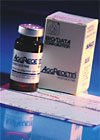Ristocetin and Impact-R
Tuesday, January 3rd, 2012Impact-R determines the degree of platelet adhesion and platelet aggregation under near physiologic conditions. Platelet adhesion is expressed as %SC or the percentage of the surface covered by platelet aggregates. Platelet aggregation is expressed as AS µm2 or the average size of the aggregates.
Sometimes, a platelet agonist is needed to assay platelet function in cases where there is defective adhesion and aggregation. One of these agonists is Ristocetin. Ristocetin is an antibiotic previously used to treat staphylococcal infections. Use was discontinued because of its lethal side-effects, thrombocytopenia and platelet agglutination. Because of these same side-effects, ristocetin is now used to diagnose certain hematologic conditions such as von Willebrand disease and Bernard-Soulier syndrome.
Ristocetin causes von Willebrand factor to bind the platelet receptor GpIb so that when ristocetin is added to whole blood, it agglutinates. The mechanism for such activity is yet unexplained but there are several hypotheses including one in which the binding of ristocetin to the platelet changes its surface charge. Ristocetin will show hypoagglutination in von Willebrand disease because of a deficiency in von Willebrand factor and in Bernard-Soulier syndrome because of a deficiency in GpIb receptor proteins in the platelet cell membrane.
Tests that use ristocetin include: Ristocetin Cofactor Activity and Ristocetin Induced Platelet Aggregation.
